EV charging stations are essential for all EV owners: current and future, and it could be a challenge to find the best EV chargers that suit you.

Driving EVs has a variety of advantages, one of which is that you never have to buy gasoline ever again. But what people do forget is that you still have to “fuel” your car, and 99.9 percent of the time you’re going to do it at home rather than somewhere at superchargers for fast charging.
You only use public charging stations for road trips. Most people charge their cars at home, and the charging time is essentially seven seconds — three seconds to plug it in and four seconds to unplug it in the next morning.
Most people are not as prepared as they should be when installing their home chargers at their home and sometimes in an apartment complex. Even if you have one right now, did you pick the right solution for your car, for yourself, or for your wallet?
What’s the process that people should go through, especially when they’re getting their first electric cars, and what is the process for them to pick the right EV charging station that suits best for the electric car they’re thinking about buying…
This article will tell you everything you need to know specifically about the benefits of owning an EV charging station, what to look for in an EV charger, and what kind of EV chargers will work for you.
If you already have one, you will see if you’ve done it right or you need to redo it. This article will walk you through all of that, so keep reading!
Top 5 Best EV Charging Stations
- Enel X JuiceBox Pro 40
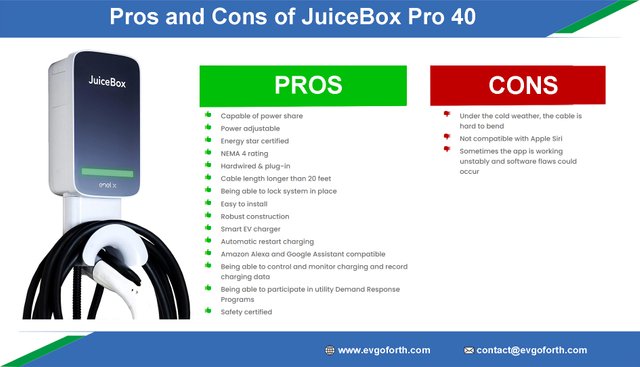
The JuiceBox Pro 40 is the second generation made by Enel X. It’s power-adjustable and can deliver up to 40 amps.
It’s energy star certified for energy efficiency. It has a big advantage — power share capability. NEMA 4 weatherproof rating for the exterior enclosure of the JuiceBox adds an extra level of protection.
If there’s a power failure and the power is restored, the EV charging station can automatically restore. The JuiceBox EV charger can work both with Amazon Alexa and Google Assistant. It’s UL listed for safety, and a three-year warranty is backed by the company.
The JuiceBox EV charging station works great with every EV on the market in North America except Tesla, and the JuiceBox can also charge a Tesla by applying an adapter.
- ChargePoint Home Flex
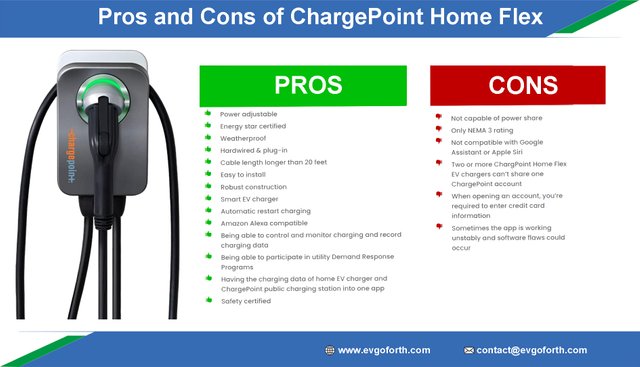
The ChargePoint Home Flex is the company’s latest model. It offers flexible charging output of up to 50 amps, and to get 50 amps, you should hardwire the Home Flex for safety. It’s limited to 40 amps output with the included plug.
The Home Flex EV charger comes with a NEMA 14–50 or NEMA 6–50 plug, energy star certified and can work with Amazon Alexa. The home EV charger can be installed inside the house or out. Hardwiring it is highly recommend if you want to mount the EV charger outside.
It’s UL listed for safety. The ChargePoint offers a three-year warranty, which is pretty much the standard for high-quality home charging equipment made by reputable manufacturers today.
The ChargePoint Home Flex charger is proper for all electric cars on the road with the standard J1772 charging ports in the US.
- Grizzl-E Classic EV Charger
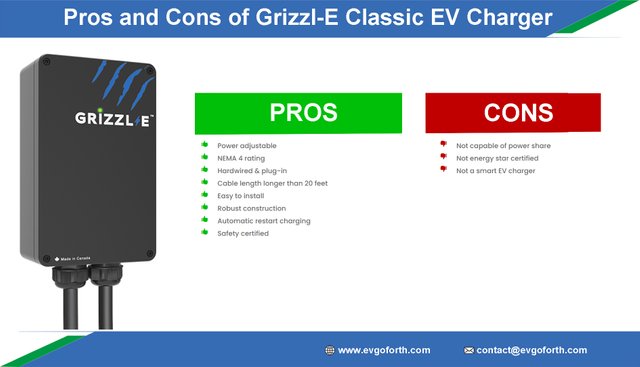
The Grizzl-E Classic EV Charger, one of the strongest EV chargers available today, is made in Canada and manufactured by United Chargers.
It can adjust power up to 40 amps. However, it’s not energy star certified. In terms of cable flexibility, the cable performs at an average level under cold weather. A remote connector holster that works well is what the charger has.
It’s also a NEMA 4 rated charger, so it is very suitable for outdoor installation because the outer case offers excellent protection from even blowing snowstorms and rainstorms.
The Grizzl-E Classic is a non-smart charger, and it doesn’t have smart charging features. But it still can resume charging after the power is restored. The charger is safety certificated.
Therefore, if you need a charger to plug it in and charge your electric car simply, the Grizzl-E Classic EV Charger may be your best option.
- OpenEVSE Advanced Series 48 EV Charger
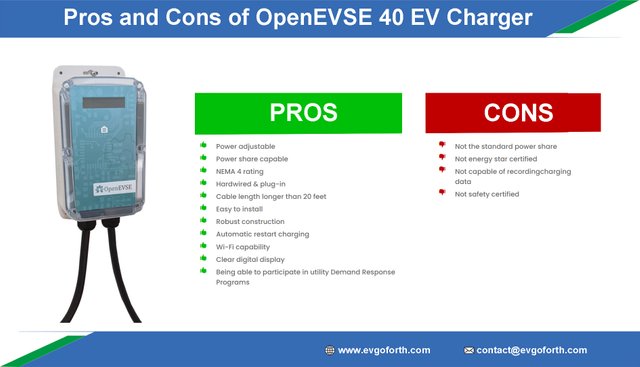
The OpenEVSE Advanced Series 48 EV Charger is power-adjustable and can deliver 48 amps to the EV.
It’s capable of power share, but you will need the company to configure it for you. By default, two OpenEVSE chargers can’t share one single circuit if you just order chargers online and get them at your home.
It’s not energy star certified and has a remote connector holster to hold the cable. The NEMA 4 weatherproof rating makes the charger stronger to go against extreme weather.
Although the OpenEVSE is a smart charger, it doesn’t communicate with Amazon Alexa or Google Assistant. The resume charging feature still works for the charger.
The OpenEVSE is not safety certificated, but the company uses UL components to make the charger.
Overall, the OpenEVSE is a high-powered home EV charging station with good quality at an affordable price.
- ClipperCreek HCS-40P EV Charger
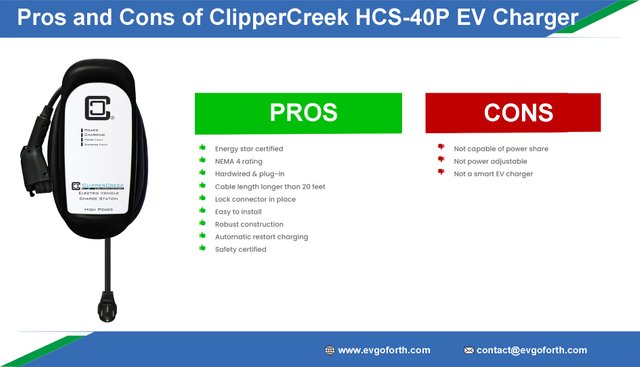
The ClipperCreek HCS-40P is a solid EV charging station, one of the better options for EV drivers on the market today. It can deliver 32 amps (7.7 kW), coming with either the NEMA 14–50 or NEMA 6–50 plug.
It’s energy star certified, which means that it doesn’t waste energy when it’s not in use.
The ClipperCreek HCS-40P is NEMA 4 rated, which is an excellent NEMA rating so that it works well under extreme weather conditions. It’s as good as you can get for an outdoor rating with an electric car charger.
The connector holster has a good design and excellent for outdoor use.
Even if the ClipperCreek HCS-40P is not a smart charger, it is a well-built charging station made in US.
EV Charging Station — What is It?
An EV charging station provides the power to charge electric cars just like a gasoline station provides the gas to conventional ICE (Internal Combustion Engine) vehicles.
EV charging stations are also referred to as electric vehicle supply equipment or EVSE. They are actually not “EV chargers”. That’s because “EV chargers” are built into the cars, and the EV charging stations or EVSE are devices that simply supply electricity safely to the EVs.
However, the general public doesn’t use the term EVSE and just calls them “EV chargers”. Even EV charging station companies refer to “charging stations” as “chargers” on their websites. So in order for mass adoption and for the purpose of what this article is talking about, we use the term” charging stations” or “chargers”.
Get an EV Charging Station — Why?
There are several benefits of owning an EV charging station and charging your EV at home.
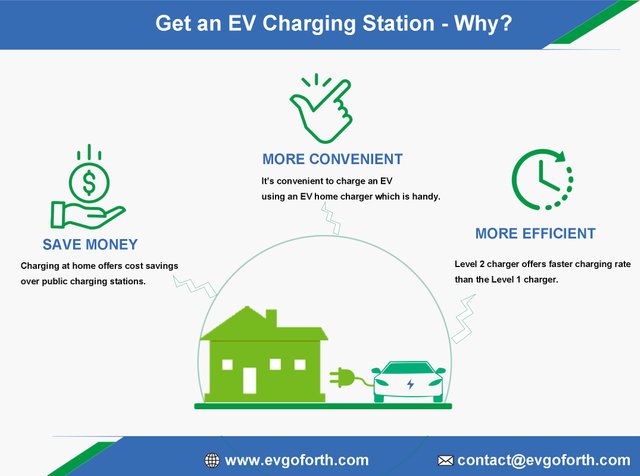
Save money — Charging at home offers cost savings over public charging stations. Although EV owners need to pay money to get the EV chargers, it’s worth the investment.
Federal and State rebates and incentives for purchasing and installing EV chargers may be available for EV drivers.
In addition to that, EV owners can avoid high energy costs if they apply home solar system for EV chargers. Even if purchasing and installing solar panels costs money, they can save a lot by using their own generated energy in the long run.
More convenient — It is convenient to charge your EV at home by using an EV charger. It provides peace of mind because the EV home charger is handy.
Even though there may be public charging stations nearby, it could still be risky when the charging stations are in use, and you have to wait in a long line of cars.
More efficient — Most of the EVs come with a standard 120-volt charging cord (Level 1 charger), making it possible to charge EVs from a regular household outlet, but it’s highly inefficient. The charging time varies between 17–24 hours for EVs to reach full charge.
In comparison, it takes 3–10 hours using a 240-volt charging outlet (Level 2 charger) to fully charge EVs. We can see that the Level 2 charger offers significantly faster charging speed than standard home outlet charging using the Level 1 charger.
Level 1 and Level 2 Charger-What’s the Difference?
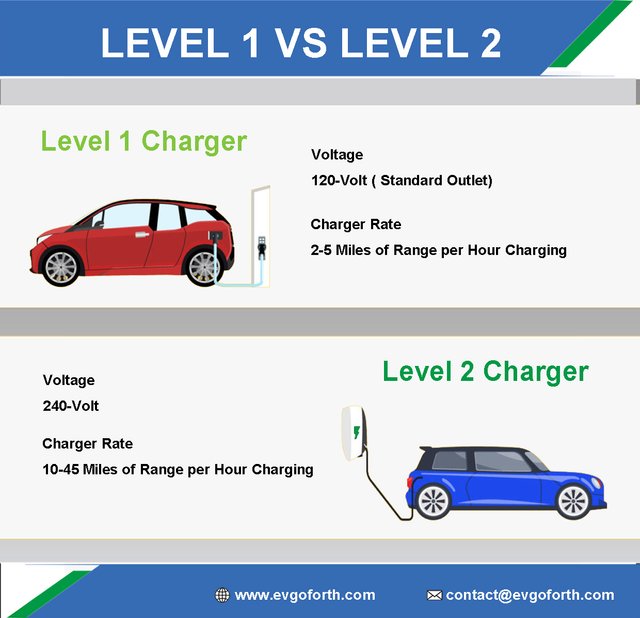
Considerations Before Purchasing an EV Charging Station
Before trying to figure out how to choose a home charging station, you have to consider that if you really need to purchase one and if you can install the charging station.
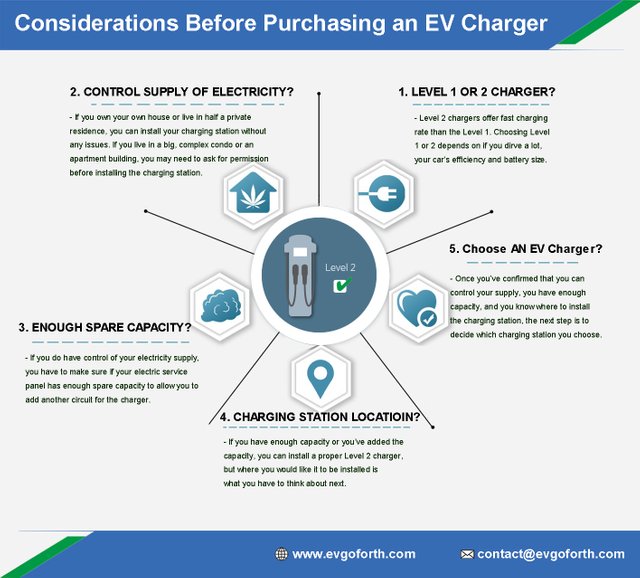
Do You Need a Level 2 Charger or Level 1 Charger That Comes with the Car?
If you own or will own a plug-in hybrid electric vehicle (PHEV), a Level 1 charger would be enough. A PHEV, like the Chevrolet Volt, has a shorter range and much smaller battery pack than battery-electric vehicles (BEVs), which means you don’t need to charge it necessarily at such a high rate using a Level 2 charger.
Level 1 charger can re-charge the entire range overnight. Of course, you can still get a Level 2 charger to keep re-charging it up again quickly after it depletes its tiny battery.
If a BEV is your option and you don’t drive a lot, you still can get away with Level 1 without needing to install anything fancy or expensive. Since Level 1 charger can’t completely charge cars overnight, all-electric vehicles will be a lot better off with a level 2 charger.
In other words, from practical experience, the charging capacity you need is mostly related to how many miles you drive per day (or per charging period) and how efficient your car is. The battery size is the second factor.
You probably only need a Level 1 charger if you typically have a 15-mile daily commute distance during the week, regardless of whether your PH/EV has an 8.8KWh battery (Prius Prime) or a 100KWh battery (Tesla Model S).
If you need to go a bit further and burn down your battery a lot, it would be more convenient and charging faster using Level 2 chargers.
Do You Control the Supply of Electricity?
If you own your own house or live in half a private residence, you can install your charging station without any issues.
If you live in a big, complex condo or an apartment building, you may need to ask for permission before installing the charging station.
California passed the right-to-charge legislation that basically says you have the right to charge your electric car as long as you’re willing to pay for the equipment, the installation, the meter and the electricity. However, this is still a problem across the country that EV owners aren’t allowed to put in a charging station for their EVs.
Do You Have Enough Spare Capacity?
If you do have control of your electricity supply, you have to make sure if your electric service panel has enough spare capacity to allow you to add another circuit for the charger.
Many of the older homes don’t meet the standard. When you install a 30, 40, or 50-amp dedicated circuit for the proper Level 2 charger, service panels are completely maxed out, not to mention more charging stations. Thus you have to consider if you have to upgrade your service panel to install the charging station.
When you want to charge two EVs using a Tesla wall connector and ChargePoint Home Flex charger at a fast speed at the same time, will you install one dedicated circuit or two, or just get a Splitvolt Splitter Switch to share a single dedicated circuit with?
Consult a qualified electrician, and a good electrician will tell you the cheapest and quickest way to get what you need honestly.
Where would You Like to Locate the Charging Station?
If you have enough capacity or you’ve added the capacity, you can install a proper Level 2 charger, but where you would like it to be installed is what you have to think about next.
Electric cars have different locations for their charge ports. The closer the charging station is to the car’s charging port, the more convenient it would be.
So make sure you know the location of your charging port on your car and the length of the cable on the charger before installing your charging station.
What EV Charging Station Features are Important to Consider?
Once you’ve confirmed that you can control your supply, you have enough capacity, and you know where to install the charging station, the next step is to decide which charging station you choose.
There are many charging stations on the market. Let’s walk you through various features that matter when deciding which charger is right for you.
Power
Charging stations have different levels of power, varying from 16–80 amps. You need to pair that with what your can accept.
Even if your EV can only take 16 amps, with an eye on the future, get a charger that can deliver at least 32 amps, preferably 40 amps. The cost to get a slightly high powered station is minimal, but what you get then is your future-proofing.
Safety Certified
There is a demand of charging stations, so many small start-ups are popping up crazily and make charging stations. However, most of these Level 2 chargers have poor quality and not safety certified.
For electric car charging, it’s considerably important that the unit is safe. You do the EV charging almost every day. It could be the largest electricity draw in your house for many hours at a time every day.
More electricity will pass through this charger every single day than anything else in your house including your central air conditioning, pool pump, and your electric dryer. So you want it to be well built and able to last for years.
You don’t know what you’re getting if it hasn’t been safety certified. It might be a suitable charging station, but it might not be.
If charging station companies plan on selling this product for a long time, they will do this safety certification test through well established testing entities like Underwriters Laboratory (UL) in the US. The UL safety certification label is displayed on the side of the box or the website.
Charging Station Cable Length
Some charging stations offer a standard 16-foot cable. For most EV owners, it’s not long enough.
You may want to be able to reach any point in your garage, and your drive way. Because some days you have to park in different positions, and you don’t want the cable not to be able to reach. So at least 20 feet in length is our recommendation.
Some of the good chargers, like ChargePoint Home Flex EV charger, ClipperCreek EV charger, and Enel X JuiceBox EV charger, come standard with 24–25 feet long cables, which is definitely ideal if you mount the charging station outside.
NEMA 3 or NEMA 4 Rated Chargers
NEMA 4 is better than NEMA 3. They’re both rated for outdoor use, but NEMA 4 can withstand blowing wind and can actually withstand a direct spray from a hose. If you took your hose and sprayed it directly on the charging station, water would not get into it.
NEMA 3 is rated for outdoor, but if you took your hose and sprayed water right on it, water would get inside the enclosure to the electronics.
ChargePoint Home Flex is a good unit, but it is a NEMA 3 rated device. It’s excellent for indoor use.
If you like an extra level of security and would like to mount the charging station outside, the NEMA 4 rated devices, like ClipperCreek and Enel X JuiceBox, more robust for outdoor use, can be on the list of your choices.
If you mount the charging station on the inside, but run the cable to the outside when you end up parking the car outside, NEMA 3 rated charging station should be working just fine.
If you mount the whole charging station unit outside and it’s not going to be in any enclosure or covered space where you can get blowing rain and wind, choosing NEMA 3 or NEMA 4 rated chargers depends where you live.
If you live in sun kissing San Diego, or California, it might not be a big problem to use a NEMA 3 rated charging station, but if you live in some of the states with regular sever weather conditions, it would be better to apply a NEMA 4 rated unit. You have to make your own decision on what kind of charging station you should choose.
Hardwired or Plug-In Charging Stations
Hardwired charging stations are permanently connected to the electricity supply, which could be an issue if you have to move a lot.
Before moving, you will have to hire an electrician and drywall patchier (because most electricians do not offer to patch up the holes in your walls), and cost money. A plug-in unit isn’t permanently installed and you can hardwire it if you’d like to.
Portability
You can take it along with you to charge your EV at a different location, like in your relatives’ house if they have a suitable 240-volt power outlet.
If there’s a problem, and you need to return it, you just need to unplug it, put it in a box, send it back rather than having to have your electrician come out and pull the wires and disconnect it. Then you have to pay for that. The charging station might give you a new unit, but you’re not going to get your reimbursement for your electrician’s work.
Easier and Cheaper Installation
You just need to have a licensed electrician come and install a 240-volt outlet. It’s either a NEMA 14–50 or a NEMA 6–50 outlet, and then you just plug the charging station in.
In our opinion, all houses will have a suitable power outlet (i.e., 240-volt outlet) in the near futrue to pair the demand for EVs and charging stations.
Smart or Dumb Chargers
A smart charger has either a Wi-Fi or PLC connection. They’ll come with a smartphone app. You can know exactly how much energy the car is using or charging. The app keeps track of all of that. You can determine exactly how much money to pay for your charging sessions.
In addition to that, a lot of the utilities have been starting Demand Response Programs. If you want to sign up and agree to be in these demand response programs, you need to have a smart charging station.
You give your utility the right to control your smart charger remotely. You set a goal, let’s say, at least 80% charged by 6 am. They can throttle back your car charging or even delay it a few hours, but they will reach the goal.
One of the social benifits of giving the control of charging your car to utility suppliers is that they could adjust their power generation from renewable resources, namely wind power, to the time of your need so there is no waste of clean energy.
In return, they can offer you tremendous discounts, and sometimes it’s 50% off the cost to charge your car. In other words, some utility companies charge more if you’re charging your EV using electricity at certain parts of time, and having that smart charger helps you just to charge your car at a time where the electricity is cheaper.
Besides, if you have solar panels, a smart charger is the best type for its convenience. When the car is connected to the smart charger, it can be set to charge when it is most economical or at certain times to maximize solar power supply.
How to Install an EV Charging Station at Your Home?
Consult a licensed electrician. It can save a life, and prevent your insurance policies from being deemed invalid in the event of a fire or you from being sued by a third party in the event of injury, death, or property damage.
Conclusion
This article is a guideline to let you know what you should be looking for in an EV charging station and our thoughts on it, but everybody has specific needs.
For instance, if you live in Canada, where it’s extensively cold through many months of the year, and you get heavy snowstorms, you may want to consider a NEMA 4 rated charger because that fits your personal needs better.
Compare those EV chargers side by side, and then make your own decision on which charger is best for you.